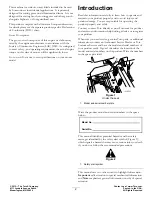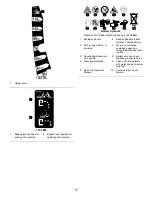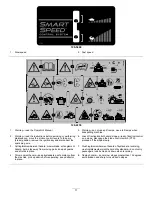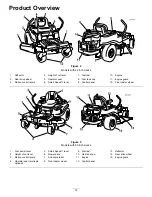
•
When using any attachments, never direct discharge of
material toward bystanders nor allow anyone near the
machine while in operation.
•
Never operate the machine with damaged guards or
without safety protective devices in place.
•
Do not change the engine governor settings or overspeed
the engine. Operating the engine at excessive speed can
increase the hazard of personal injury.
•
Before leaving the operator's position:
–
disengage the power take-off and lower the
attachments;
–
change into neutral and set the parking brake;
–
stop the engine and remove the key.
•
Disengage drive to attachments, stop the engine, and
disconnect the spark plug wire(s) or remove the ignition
key
–
before clearing blockages or unclogging chute;
–
before checking, cleaning or working on the lawn
mower;
–
after striking a foreign object. Inspect the lawn
mower for damage and make repairs before restarting
and operating the equipment;
–
if the machine starts to vibrate abnormally (check
immediately).
•
Disengage drive to attachments when transporting or not
in use.
•
Stop the engine and disengage drive to attachment
–
before refuelling;
–
before removing the grass catcher;
–
before making height adjustment unless adjustment
can be made from the operator's position.
•
Reduce the throttle setting during engine run-out and, if
the engine is provided with a shut-off valve, turn the fuel
off at the conclusion of mowing.
•
Lightning can cause severe injury or death. If lightning
is seen or thunder is heard in the area, do not operate
the machine; seek shelter.
Maintenance and Storage
•
Keep all nuts, bolts and screws tight to be sure the
equipment is in safe working condition.
•
Never store the equipment with fuel in the tank inside a
building where fumes can reach an open flame or spark.
•
Allow the engine to cool before storing in any enclosure.
•
To reduce the fire hazard, keep the engine, silencer,
battery compartment and fuel storage area free of grass,
leaves, or excessive grease.
•
Check the grass catcher frequently for wear or
deterioration.
•
Replace worn or damaged parts for safety.
•
If the fuel tank has to be drained, this should be done
outdoors.
•
When machine is to be parked, stored or left unattended,
lower the cutting means.
Toro Riding Mower Safety
The following list contains safety information specific to Toro
products or other safety information that you must know that
is not included in the CEN standard.
•
Engine exhaust contains carbon monoxide, which is an
odorless, deadly poison that can kill you. Do not run
engine indoors or in an enclosed area.
•
Keep hands, feet, hair and loose clothing away from
attachment discharge area, underside of mower and any
moving parts while engine is running.
•
Do not touch equipment or attachment parts which may
be hot from operation. Allow to cool before attempting
to maintain, adjust, or service.
•
Battery acid is poisonous and can cause burns. Avoid
contact with skin, eyes and clothing. Protect your face,
eyes, and clothing when working with a battery.
•
Battery gases can explode. Keep cigarettes, sparks, and
flames away from battery.
•
Use only genuine Toro replacement parts to ensure that
original standards are maintained.
•
Use only Toro-approved attachments.
Slope Operation
•
Do not mow slopes greater than 15 degrees.
•
Do not mow near drop-offs, ditches, steep banks, or
water. Wheels dropping over edges can cause rollovers,
which may result in serious injury, death, or drowning.
•
Do not mow slopes when grass is wet. Slippery
conditions reduce traction and could cause sliding and
loss of control.
•
Do not make sudden turns or rapid speed changes.
•
Use a walk behind mower and/or a hand trimmer near
drop-offs, ditches, steep banks, or water.
•
Reduce speed and use extreme caution on slopes.
•
Remove or mark obstacles such as rocks, tree limbs, etc.
from mowing area. Tall grass can hide obstacles.
•
Watch for ditches, holes, rocks dips, and rises that change
the operating angle, as rough terrain could overturn the
machine.
•
Avoid sudden starts when mowing uphill because the
mower may tip backwards.
•
Be aware that loss of traction may occur going downhill.
Weight transfer to the front wheels may cause drive
wheels to slip and cause loss of braking and steering.
•
Always avoid sudden starting or stopping on a slope.
If tires lose traction, disengage the blades and proceed
slowly off the slope.
5
Содержание TimeCutter ZS 4200
Страница 12: ...121 0772 1 Fast 4 Choke 2 Continuous variable setting 5 Power take off PTO Blade control switch 3 Slow 12 ...
Страница 13: ...121 0773 1 Fast 4 Choke 2 Continuous variable setting 5 Power take off PTO Blade control switch 3 Slow 13 ...
Страница 52: ...Schematics G014644 Electrical Diagram Rev A 52 ...
Страница 53: ...Notes 53 ...
Страница 54: ...Notes 54 ...






































